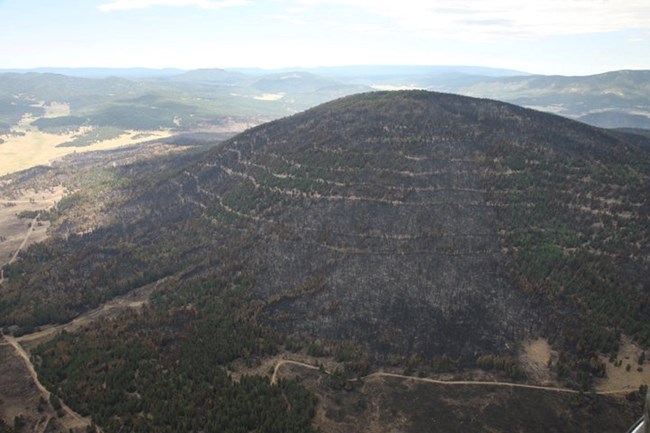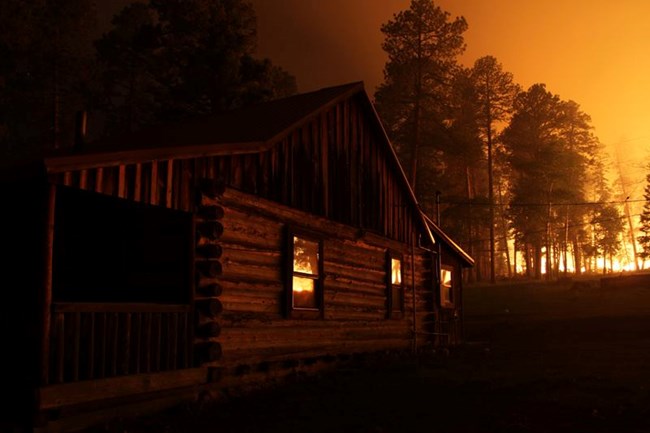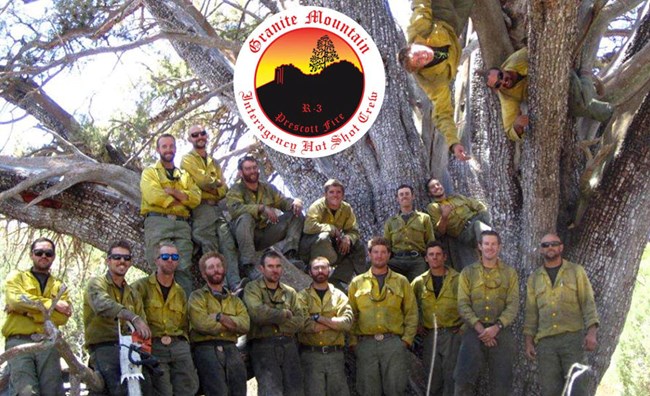Part of a series of articles titled A Stewardship of Storytelling.
Article
"The History Grove" by Melissa Fu

Courtesy of Michael Mudd
I’m grateful to be among these giants. I sit and listen to the wind ruffling the boughs as morning light stretches the shadows. Simply being among them, sensing their magnitude brings a sense of calm and perspective. I’m awestruck, too, considering how long they have stood here at the boundary of the foothills and the montane grasslands. Through centuries of winter snows, spring thaws, and summer monsoons, they have witnessed parades of creatures — human, mammal, avian, reptilian, and insect — pass by under their canopies.
I especially love the ponderosa pines. When they have sufficient space, as they do here, ponderosas boast full canopies. Their branches can stretch out for sunlight in all directions around the trunk. The self-pruning scars from dropping low branches in their younger years have been absorbed into the thick, red, bark that smells of vanilla and cinnamon. Their canopy from base to crown is maybe half to two thirds of their full height, sometimes over 100 feet. Ponderosas host bluebirds, woodpeckers, hummingbirds, flickers, owls, and a whole array of insects. Their shade shields the understory, home to mice and other small rodents. At their feet, a blanket of leaf litter and duff patiently mixes and decays with the perennial grasses and pinecones, returning nutrients and minerals to the soil for new growth. They are the most magnificent creatures.
To walk among these giants in History Grove is to feel completeness, humility and wisdom. It is a cathedral, a sacred space.

Courtesy of Rourke McDermott
Many of the domes of Valles Caldera were once covered with forest like this. Along with the band of trees in the Cabin District where I am staying, the trees in History Grove are among the few ancient giants not lost to the logging that took over 95% of the majestic forests that stood in Valles Caldera for centuries. I wonder about the decision to spare these trees.
In the early and mid-decades of the 20th century, Valles Caldera was not an easy place to live or work. Isolated location, harsh winters, few amenities, rough dirt roads, and the fear of bears, mountain lions and coyotes were just some of the challenges. Those who stayed here must have found something to keep them from retreating down to the cities of Santa Fe or Albuquerque. I imagine that to stay here, people must have liked it, even loved it. Something kept the logging company from knocking down all the old trees. Maybe despite all their acquisitiveness, they, too, thought the trees were beautiful. There must be a story there.
For all the past practices that sadden my modern-day sensibility, I am grateful that at least this grove was left intact. I like to think it points to an affinity and fondness for the land beyond economic utility. Even if the primary impulses were to work and exploit the land, perhaps this remaining section of forest indicates a deeper instinct at work, holding back from complete destruction, suggesting that some things should be left alone.

Courtesy of Kristen Honig
On May 31st, 2013, a downed power line ignited the Thompson Ridge fire which ultimately burned 24,000 acres, most of which was in Valles Caldera. History Grove and the Cabin District were nearly lost in the blaze. Less than 100 meters from the cabin where I am staying, fire fighters started a backburn to prevent the fire from engulfing these historic areas. It is bewildering to realize how close we came to losing these stands of wisdom and magnificence. The Granite Mountain Hotshots, a crew of interagency, elite type-1 wildland fire fighters based out of Prescott, Arizona, were instrumental in saving the Cabin District and History Grove. They worked furiously through the night of June 6th to keep this old-growth grove and the cabins safe. Because of them, History Grove still stands.

Courtesy of Arizona State Parks & Trails
I first learned of the Granite Mountain Hotshots’ work at Thompson Ridge and the subsequent tragedy at Yarnell Hill in Laura Paskus’s book At the Precipice, New Mexico’s Changing Climate (2020). The Granite Mountain Hotshots were certainly heroes. They were also brothers, sons, fathers, husbands, partners, friends. They were complete, complex individuals, and their profound loss will always be felt within the firefighting community. Their stories are told in depth and with great compassion in Fernanda Santos’s book, The Fire Line: The Story of the Granite Mountain Hotshots (2017), and Kyle Dickman’s book On The Burning Edge (2015). I found both books to be invaluable in presenting comprehensive pictures of the lives, families and communities of the Granite Mountain Hotshots.
Though I didn’t know any of them, I feel immense gratitude and sorrow when I think of their work here in Valles Caldera. Laura Paskus pauses in her book to include their names. It seems fitting to echo that gesture of remembrance and respect:
- Andrew Sterling Ashcraft
- Robert E. Caldwell
- Travis Clay Carter
- Dustin James DeFord
- Christopher A. Mackenzie
- Eric S. Marsh
- Grant Quinn McKee
- Sean M. Misner
- Scott Daniel Norris
- Wade S. Parker
- John J. Percin, Jr
- Anthony M. Rose
- Jesse James Steed
- Joe B. Thurston
- Travis Turbyfill
- William Howard “Billy” Warneke
- Clayton Thomas Whitted
- Kevin J. Woyjeck
- Garret Zuppiger
What will the future hold for these trees and the larger forested areas of Valles Caldera? Climate future models predict two possibilities, one classified as Warm Wet and the other as Hot Dry. Among other things, the models differ in the amounts, frequencies, and forms of yearly moisture predicted (snowfall or rainfall). But both predict a high probability of warmer temperatures and less snowpack in Valles Caldera. Will these shifts lead the forests of Valles Caldera to change from mixed conifers to species better adapted to hotter, drier climates? It’s hard to know and sobering to contemplate. Still, predictions and models like this can inform stewardship and preservation choices. I’m grateful for this research.
That the forest will reach for recovery after a disturbance is inevitable, but whether it will return to the forest it used to be or undergo a “type change”, becoming home to different kinds of flora is less certain. Each burned or wounded area heals differently, depending on multiple factors including burn severity, health of surrounding microclimates, and direction of its exposure to sun and wind patterns.
Gazing again at the grove, an area of tufted green catches my eye. I carefully climb over massive trunks lying on the ground, some dry and naked of their bark, some still with bark intact. They lie across one another like pick-up sticks. I creep closer. In the middle of the area of fallen trees, there is a grove of baby trees. They are Douglas firs, the size of Christmas trees. Off to the sides stand some sapling ponderosas, maybe 1.5 meters tall. In the shadows and under the careful watch of the older giants of History Grove, a small new forest grows defiantly, proudly among the grasses. They look like a band of brothers. They look like hope. Maybe, just maybe, these trees have a future, springing from the heart of History Grove.
Descriptive Transcript
Six video clips showing different scenes in and around a stand of mature ponderosa pine trees: 1. The edge of the forest meets a vast grassland with snowy mountain peaks in the background. 2. A tiny pine seedling blows in the wind at the edge of the mature forest. 3. The bases of 6 tree trunks meet tall, yellow grasses. 4. Tall, yellow grasses blow in the wind at the edge of a mature stand of pines. 5. A pine cone drops to the ground at the base of 4 large pines. 6. Looking into the stand of mature pines, which have plenty of space between them and tall, yellow grass growing across the forest floor.
- Duration:
- 47.18 seconds
A variety of scenes in and around History Grove, a stand of old-growth ponderosa pines overlooking Valle Grande.
Last updated: December 9, 2024
